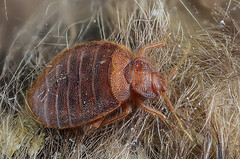
flic.kr/p/a758YY
Bed bugs are tiny insects that do not have wings. Roughly, they are oval-shaped. Once fully grown, they measure from four to five millimeters long. You might find the next piece of information unexpected, but yes, bed bugs are fast runners!
They are easy to see on white marble floors or linoleum, but very difficult to spot on brown wooden floors. This is so because bed bugs are rust brown in color and they even change into a deeper red brown color when they finish a complete blood meal.
The fact that bed bugs are dorsoventrally flat helps their distribution. Since they are so thin, they can squeeze in and fit in very crevices and narrow cracks, oftenly ones that may be found on the floor. Because of their great skillful hiding ability, bed bugs are very hard to detect.
Bed bug distribution also adds up to any pieces of information on the two main species of bed bugs that bite human beings.
First is the common bed bug, more scientifically known as cimex lectularius. This kind of bed bug is found in any crevice as long as it is within room temperature. And they are of greater distribution in Australia. May it be remote or urban, common bed bugs do not care, only as long as they are distributed to an area that copes well with their requirements.
Another kind of bed bugs is the tropical bed bug, called cimex hemipterus. This bed bug has been thought to be distributed in the tropics a long time ago but it was only recently recognized by the medical entomology department. This department can tell you great information about the distribution of the cimex hemipterus in the tropics.
Bed bugs are also distributed finely in human dwellings, bird’s nests and bat caves. In fact, the habitats recently mentioned are the ones found to be most suitable for these said bed bugs. Why? The reason seems to be quite obvious. Bed bugs are distributed to these homes because of their offered warmth and hosts they can feed on.
However, you must always bear in mind that bed bugs are never evenly distributed throughout the environment. You will notice that instead of being distributed in the environment, bed bugs are distributed mainly in harborages.
When human dwellings is the subject, the harborages are inclusive of the crack and crevices that you can find, sometimes not find in furniture and wood paneling, in your house’s walls, behind your wallpaper, or even under your carpeting.
Usually, bed bugs are not so prone to activity during the night, but will feed on anything during the day, especially when hunger strikes. So, most probably, these bed bugs would be distributed to trees and leaves and roots and absolutely anything that they can land on and strike their fancy.
Bed bugs can also be distributed in bedding, to clothing, or even your luggage. However, much to their dismay, they do not have appendages that could allow them to cling, possibly to fur or hair feathers. This would bring you to the conclusion that bed bugs leave to feast on their hosts but once done, they leave their hosts since they have nothing to cling with in the first place.
Adult bed bugs survive exclusively as parasites that feed mainly on warm-blooded animals, the best example, and probably the most usual, would be human beings. Since bed bugs can be distributed to poor housing conditions, then it would be conclusive that the infestations of bed bugs can be discovered in these places too. And if these bed bugs easily get distributed to domestic premises, then the room they will most probably attack is the bedroom.
You already know that bed bugs are distributed to cracks and crevices where they most typically hole up, but you probably would find this quite surprising. Throughout this essay, have you ever asked yourself why these insects are called bed bugs? It is because they love to distribute themselves in bedrooms, particularly in the vicinity of where the host, in this case, human beings, sleeps. Most often, they would even habitate in the host’s sleeping place itself, the bed. Its distribution in bedrooms also include bed frames, behind skirting or wallpaper and the mattress itself.
Tagged with: bed bugs control • pests control
Filed under: Bed Bugs